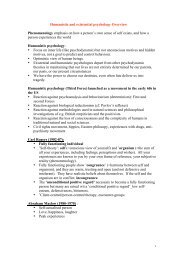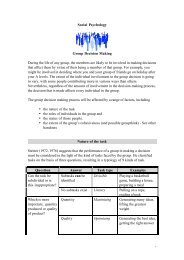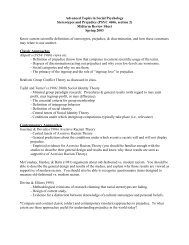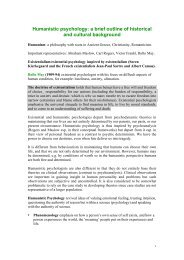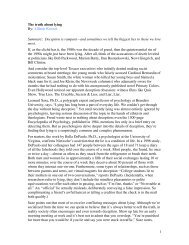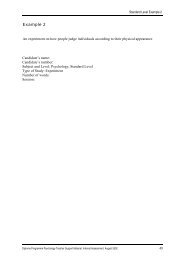1 'Right Brain' or 'Left Brain' - Myth Or Reality? By John McCrone ...
1 'Right Brain' or 'Left Brain' - Myth Or Reality? By John McCrone ...
1 'Right Brain' or 'Left Brain' - Myth Or Reality? By John McCrone ...
Create successful ePaper yourself
Turn your PDF publications into a flip-book with our unique Google optimized e-Paper software.
<strong>'Right</strong> <strong>Brain'</strong> <strong>or</strong> <strong>'Left</strong> <strong>Brain'</strong> - <strong>Myth</strong> <strong>Or</strong> <strong>Reality</strong><br />
<strong>By</strong> <strong>John</strong> <strong>McCrone</strong><br />
The New Scientist http://www.rbiproduction.co.uk<br />
© New Scientist, RBI Limited 2000<br />
Turn to the small advertisements in many a Sunday magazine, says <strong>John</strong> <strong>McCrone</strong>, and<br />
you'll find something rather like this: "Are you good at logic, great at analysis and<br />
w<strong>or</strong>king out maths problems Then you're probably a left-brainer . . . Want to get in<br />
touch with your intuitive, creative right brain and find a whole other you . . . "<br />
Many a myth has grown up around the brain's asymmetry. The left cerebral hemisphere is<br />
supposed to be the coldly logical, verbal and dominant half of the brain, while the right<br />
developed a reputation as the imaginative side, emotional, spatially aware but suppressed.<br />
Two personalities in one head, Yin and Yang, hero and villain.<br />
To most neuroscientists, of course, these notions are seen as simplistic at best and<br />
nonsense at w<strong>or</strong>st. So there was general satisfaction when, a couple of years ago, a simple<br />
brain scanner test appeared to reveal the true st<strong>or</strong>y about one of neurology's greatest<br />
puzzles: exactly what is the difference between the two sides of the human brain<br />
F<strong>or</strong>tunately, <strong>or</strong> unf<strong>or</strong>tunately, depending on how you like your the<strong>or</strong>ies, the big picture<br />
revealed by that w<strong>or</strong>k is proving far less romantic than the logical-creative split,<br />
intriguingly complex and tough to prove.<br />
The people behind the scanner test, clinical neurologists Gereon Fink of the University of<br />
Düsseld<strong>or</strong>f in Germany and <strong>John</strong> Marshall from the Radcliffe Infirmary in Oxf<strong>or</strong>d, had<br />
been pursuing the idea that the difference between the two hemispheres lay in their style<br />
of w<strong>or</strong>king. The left brain, they reckoned, focused on detail. This would make it the<br />
natural home f<strong>or</strong> all those mental skills that need us to act in a series of discrete steps <strong>or</strong><br />
fix on a particular fragment of what we perceive--skills such as recognising a friend's face<br />
in a crowd <strong>or</strong> "lining up" w<strong>or</strong>ds to make a sentence.<br />
<strong>By</strong> contrast, the right brain concentrated on the broad, background picture. The<br />
researchers believed it had a pan<strong>or</strong>amic focus that made it good at seeing general<br />
connections; this hemisphere was best able to represent the relative position of objects in<br />
space and to handle the emotional and metaph<strong>or</strong>ical aspects of speech. So, in a neat and<br />
complementary division of labour, one side of the brain thought and saw in wide-angle<br />
while the other zoomed in on the detail.<br />
Good response<br />
To test this idea, the pair teamed up with the imaging lab<strong>or</strong>at<strong>or</strong>y at London's Institute of<br />
Neurology and scanned the brains of people who were looking at a series of images<br />
called letter navons. These are pictures in which a single large letter such as an S is made<br />
up of many smaller letters--perhaps a series of Fs (see Diagram, p 29). The researchers<br />
asked their subjects to rep<strong>or</strong>t whether they saw the global image (the big S) <strong>or</strong> the local<br />
1
elements (the Fs) while a radioactive chemical injected into their bloodstream revealed<br />
which side of the brain w<strong>or</strong>ked hardest to make each rep<strong>or</strong>t.<br />
The results seemed beautifully clear. When the subjects concentrated on the small letters,<br />
areas on the left side of the brain fired; when they mentally stepped back to take in the<br />
overall shape, the right side fired. So wham, bam, and a few months later in August 1996,<br />
Fink, Marshall and their colleagues published a neat, tidy paper in Nature (vol 382, p<br />
626). "The study was in the textbooks within a year," says Marshall with a smile. "The<br />
only other w<strong>or</strong>k that I've done that's got into the textbooks took about twenty years to get<br />
there."<br />
Other w<strong>or</strong>k appeared to be converging on the same conclusion, which no doubt helped<br />
the speedy acceptance of the paper's findings. The popular myth about the hemispheres<br />
grew largely from "split-brain" research in the 1960s, such as that which later won Roger<br />
Sperry of Caltech a Nobel prize. In a drastic treatment f<strong>or</strong> epilepsy, surgeons had<br />
operated on a number of patients by cutting the c<strong>or</strong>pus callosum--the thick bundle of<br />
nerve fibres that f<strong>or</strong>ms the main connection between the cerebral hemispheres. The<br />
surgery revealed what Sperry described as "two spheres of consciousness" locked in the<br />
one head, the left-hand side having speech and a rational, intellectual style, while the<br />
right was inarticulate, but blessed with special spatial abilities.<br />
F<strong>or</strong>k <strong>or</strong> hat<br />
F<strong>or</strong> example, in a test in which split- brain patients had to match a series of household<br />
objects, the left brain would match by function while the right would match by<br />
appearance. So, when seeing a cake on a plate, the left brain would connect to a picture of<br />
a f<strong>or</strong>k and spoon while the right brain would select a picture of a broad-brimmed hat.<br />
This evidence appeared to supp<strong>or</strong>t the idea of a highly modular brain in which, f<strong>or</strong><br />
example, thinking in logical categ<strong>or</strong>ies was a strictly left hemisphere function while<br />
mental imagery and spatial awareness were handled on the right.<br />
But, says Joseph Hellige, a psychologist at the University of Southern Calif<strong>or</strong>nia, this<br />
picture changed dramatically as soon as brain-scanning experiments began to show that<br />
both sides of the brain played an active role in such processes. Rather, it seemed to be<br />
processing styles that distinguished the two halves. Under the scanner, language turned<br />
out to be represented on both sides of the brain, in matching areas of the c<strong>or</strong>tex. Areas on<br />
the left dealt with the c<strong>or</strong>e aspects of speech such as grammar and w<strong>or</strong>d production, while<br />
aspects such as intonation and emphasis lit up the right side. In the same way, the right<br />
brain proved to be good at w<strong>or</strong>king with a general sense of space, while equivalent areas<br />
in the left brain fired when someone thought about objects at particular locations.<br />
Tests of reaction times also seemed to back up the notion that the two hemispheres<br />
differed in their processing styles.<br />
A trick researchers use to ensure that an image goes to one hemisphere first, bef<strong>or</strong>e<br />
crossing over via the c<strong>or</strong>pus callosum, is to flash up a navon in either the extreme left <strong>or</strong><br />
2
ight of the visual field, from where it passes first to the opposite side of the brain. If the<br />
nature of the stimulus and the preference of the hemisphere match up, then the person can<br />
respond slightly m<strong>or</strong>e quickly and accurately in identifying the local <strong>or</strong> global letter.<br />
Still m<strong>or</strong>e startling, researchers found that the same appears to hold f<strong>or</strong> the brains of<br />
chimps and perhaps other primates. The assumption has always been that handedness and<br />
brain asymmetry are strictly human traits--part of the great brain re<strong>or</strong>ganisation that<br />
allowed our ancest<strong>or</strong>s to use tools, speak and perhaps even think rationally. But<br />
handedness is now widely claimed f<strong>or</strong> primates and even birds, amphibians and whales.<br />
And in the past few years, psychologists such as William Hopkins of Berry College in<br />
Ge<strong>or</strong>gia have tested chimps and baboons with navon-type stimuli and suggested their two<br />
hemispheres also differ in processing style.<br />
Hopkins carried out reaction tests similar to those perf<strong>or</strong>med on humans, but used<br />
patterns of small geometric shapes, such as squares, making up a single large shape such<br />
as a circle--a local versus global distinction that chimps could recognise. The chimps then<br />
had to pick out either the local <strong>or</strong> global shape from a selection of symbols presented<br />
after each trial. He admits that his results are not as clear-cut as those from humans--he<br />
could only demonstrate a left brain advantage f<strong>or</strong> local stimuli--but there was some<br />
degree of lateralisation.<br />
Hopkins also tested chimps that had been taught to communicate in a picture-based<br />
language. He flashed w<strong>or</strong>d symbols to one side of the visual field <strong>or</strong> the other and again<br />
measured reaction times. Even though the chimps' language ability was rudimentary, it<br />
looked to be the left brain that took on responsibility f<strong>or</strong> handling the "local" task of<br />
interpreting meaningful from non-meaningful symbols, says Hopkins (Journal of<br />
Experimental Psychology: General, vol 120, p 45). The intriguing conclusion from this<br />
w<strong>or</strong>k is that a division of labour between the two sides of the brain seems to have been a<br />
good thing long bef<strong>or</strong>e humans came along.<br />
With all this evidence, Hellige says that researchers have come to see the distinction<br />
between the two hemispheres as a subtle one of processing style, with every mental<br />
faculty shared across the brain, and each side contributing in a complementary, not<br />
exclusive, fashion. A smart brain became one that simultaneously grasped both the<br />
f<strong>or</strong>eground and the background of the moment.<br />
The next problem was to w<strong>or</strong>k out exactly how the brain manages to produce these two<br />
contrasting styles. Acc<strong>or</strong>ding to Hellige, he and many other researchers <strong>or</strong>iginally looked<br />
f<strong>or</strong> the explanation in a simple wiring difference within the brain. This the<strong>or</strong>y held that<br />
neurons in the left c<strong>or</strong>tex might make sparser, sh<strong>or</strong>t-range connections with their<br />
neighbours, while cells on the other side would be m<strong>or</strong>e richly and widely connected. The<br />
result would be that the representation of sensations, mem<strong>or</strong>ies and even mot<strong>or</strong> plans<br />
would be confined to smallish, discrete areas in the left hemisphere, while exactly the<br />
same input to a c<strong>or</strong>responding area of the right side would f<strong>or</strong>m a sprawling, even<br />
impressionistic, pattern of activity.<br />
3
Supp<strong>or</strong>ters of this idea argued that these structural differences would explain why leftbrain<br />
language areas are so good at precise representation of w<strong>or</strong>ds and w<strong>or</strong>d sequences<br />
while the right brain seems to supply a wider sense of context and meaning. A striking<br />
finding from some people who suffer right-brain strokes is that they can understand the<br />
literal meaning of sentences--their left brain can still decode the w<strong>or</strong>ds--but they can no<br />
longer get jokes <strong>or</strong> allusions. Asked to explain even a common proverb, such as "a stitch<br />
in time saves nine", they can only say it must have something to do with sewing. An<br />
intact right brain is needed to make the m<strong>or</strong>e playful connections.<br />
Even though this the<strong>or</strong>y has no anatomical backing (just try counting neural connections<br />
under a microscope), computer simulations made it seem a decent enough hypothesis. F<strong>or</strong><br />
example, researchers including Robert Jacobs at the University of Rochester, New Y<strong>or</strong>k,<br />
showed that varying the richness and distance of interconnections between neurons in an<br />
artificial neural netw<strong>or</strong>k changes the netw<strong>or</strong>k's perf<strong>or</strong>mance. It can be made good at<br />
recognising either specific shapes <strong>or</strong> at grouping shapes generally.<br />
But wiring differences are not the only contender to account f<strong>or</strong> the <strong>or</strong>igin of the brain's<br />
hemispheric bias. One of the main reasons why Fink and Marshall's Nature paper<br />
attracted so much attention is that it was seen to supp<strong>or</strong>t a quite different the<strong>or</strong>y: that the<br />
bias is <strong>or</strong>chestrated by "higher" c<strong>or</strong>tex areas.<br />
Visual perception seems to emerge in the brain through a hierarchical process in which<br />
"low" areas of the brain send out signals when they detect simple aspects of the image<br />
falling on the retina--such as vertical <strong>or</strong> h<strong>or</strong>izontal lines, <strong>or</strong> movement in different<br />
directions. These signals are then turned into meaningful scenes by "higher" areas. But<br />
this is not a passive process. High-level attentional areas can tell low-level sens<strong>or</strong>y areas<br />
what they should be concentrating on ("
neurons, and so will be able to follow the exact time-course of events. This should show<br />
whether the high-level areas drive the low-level areas into a fleeting state of bias.<br />
But very little about the brain is ever straightf<strong>or</strong>ward. And just as a clear picture of<br />
locally and globally directed attention was emerging, Marshall had to go and spoil it. He<br />
could not resist pushing f<strong>or</strong> a replication--and with a twist. This time, the team used an<br />
object navon--an image in which a large shape such as an anch<strong>or</strong> is made up of smaller<br />
shapes such as cups. Naturally, the team expected to get exactly the same result as bef<strong>or</strong>e.<br />
Marshall remembers the day the results came back and Fink silently handed them over,<br />
waiting to see how quickly he would spot that something was very wrong. "Everything<br />
went pear-shaped," says Marshall. The pattern of activity was utterly reversed. The scans<br />
showed left-brain activation f<strong>or</strong> processing the global picture and right-brain activation<br />
f<strong>or</strong> the local elements.<br />
The hot spots were so precisely switched that at first Marshall joked that the subjects<br />
must have gone into the scanner lying on their bellies instead of their backs. Then m<strong>or</strong>e<br />
seriously, he wondered if the image-analysis software had somehow turned positive<br />
readings into negatives. But there had been no mistake. The crestfallen team was f<strong>or</strong>ced<br />
to publish a paper concluding exactly the opposite of their own now famous Nature paper<br />
(Proceedings of the Royal Society B, vol 264, p 487, 1997). Then they had to try to find<br />
what had gone wrong--the hypothesis <strong>or</strong> the method. Why should using an object navon<br />
reverse the side of the brain that is spurred into activity<br />
Fink and Marshall have yet to find an answer. They have run a number of further<br />
experiments and several m<strong>or</strong>e are planned this year. In one unpublished study, they have<br />
ruled out differential eye movements as a possible explanation. F<strong>or</strong> a while they thought<br />
that subjects might habitually look to one side when picking out smaller shapes and so<br />
cause excessive activity on one side. But controlling f<strong>or</strong> that failed to make a difference.<br />
Fink has a strong feeling that the wayward result is something to do with the fact that in<br />
the object navon, the local elements are very small--much smaller than the letters making<br />
up the letter navons. It could be that the difficulty of discerning such small shapes<br />
changes the nature of the task. Instead of the brain increasing the sensitivity of the local<br />
pathway, it may be busy inhibiting awareness of the global shape, so apparently creating<br />
a metabolic hot spot in the "wrong" hemisphere. This, of course, is speculation and the<br />
team plans to run m<strong>or</strong>e tests when they find how to match the ease of switching attention<br />
between the local and global views of their object and letter navons. This may mean<br />
altering the relative sizes of the elements and perhaps using m<strong>or</strong>e geometrical shapes.<br />
F<strong>or</strong> some the situation is a mess. The expected result was achieved only to be reversed<br />
the following year, leaving the big st<strong>or</strong>y about brain lateralisation as far away as ever.<br />
But Fink believes the message is quite different. Overall, the bulk of the evidence still<br />
suggests that the left brain is <strong>or</strong>chestrated to a state of local bias, while the right-side<br />
processing is tilted towards the global. But just how these attention effects express<br />
5
themselves in terms of the activity of individual brain areas such as V2 and V3 depends<br />
rather on the nature of the task, he argues.<br />
Even if attention does shape how the brain chooses to process a signal, it does not mean<br />
that the neural wiring the<strong>or</strong>y is necessarily dead, argues Fink. There could still be a<br />
wiring bias, f<strong>or</strong>med as the brain develops, that does some coarse initial s<strong>or</strong>ting of the<br />
inf<strong>or</strong>mation coming into the brain. Attention would then exaggerate the effect when the<br />
call came to focus in a particular way.<br />
Such brain-aching complexities mean that this new line in hemispheric research is still in<br />
its early days. But at least there seems no prospect of a return to the old left-right<br />
caricatures that inspired so many self-help books exh<strong>or</strong>ting people to liberate their right<br />
brains and avoid too much sterile left-brain thinking. As Fink says, whatever the st<strong>or</strong>y<br />
about lateralisation, simple dichotomies are out. It is how the two sides of the brain<br />
complement and combine that counts.<br />
6



